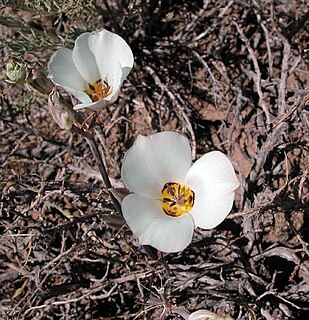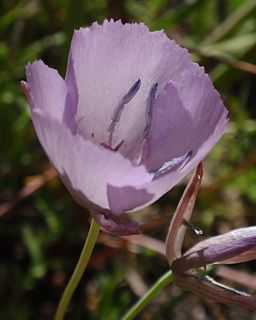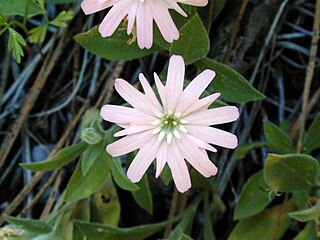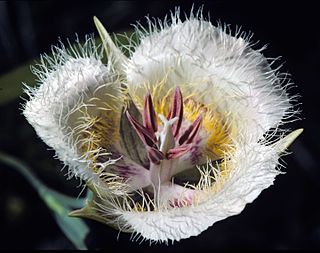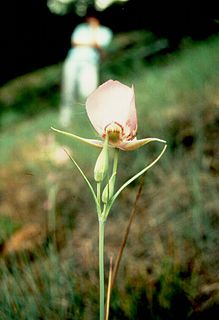| Calochortus umpquaensis | |
|---|---|
 | |
| Scientific classification | |
| Kingdom: | Plantae |
| Clade: | Angiosperms |
| Clade: | Monocots |
| Order: | Liliales |
| Family: | Liliaceae |
| Genus: | Calochortus |
| Species: | C. umpquaensis |
| Binomial name | |
| Calochortus umpquaensis | |
Calochortus umpquaensis is a species of flowering plant in the lily family known by the common name Umpqua mariposa lily. It is endemic to Oregon in the United States, where it is mainly limited to the region of the Klamath Mountains on the Little River in Douglas County, in particular the Watson and Ace Williams Mountains. [2] The flower has also been found at a single location in each of Josephine and Jackson Counties. [1]
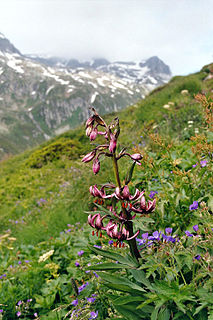
The lily family, Liliaceae, consists of about 15 genera and about 705 known species of flowering plants within the order Liliales. They are monocotyledonous, perennial, herbaceous, often bulbous geophytes. Plants in this family have evolved with a fair amount of morphological diversity despite genetic similarity. Common characteristics include large flowers with parts arranged in threes: with six colored or patterned petaloid tepals arranged in two whorls, six stamens and a superior ovary. The leaves are linear in shape, with their veins usually arranged parallel to the edges, single and arranged alternating on the stem, or in a rosette at the base. Most species are grown from bulbs, although some have rhizomes. First described in 1789, the lily family became a paraphyletic "catch-all" (wastebasket) group of petaloid monocots that did not fit into other families and included a great number of genera now included in other families and in some cases in other orders. Consequently, many sources and descriptions labelled "Liliaceae" deal with the broader sense of the family.

Endemism is the ecological state of a species being unique to a defined geographic location, such as an island, nation, country or other defined zone, or habitat type; organisms that are indigenous to a place are not endemic to it if they are also found elsewhere. The extreme opposite of endemism is cosmopolitan distribution. An alternative term for a species that is endemic is precinctive, which applies to species that are restricted to a defined geographical area.

Oregon is a state in the Pacific Northwest region on the West Coast of the United States. The Columbia River delineates much of Oregon's northern boundary with Washington, while the Snake River delineates much of its eastern boundary with Idaho. The parallel 42° north delineates the southern boundary with California and Nevada. Oregon is one of only three states of the contiguous United States to have a coastline on the Pacific Ocean.
This plant was described to science in 1989 when an isolated population of what had been reported to be Calochortus howellii was shown to belong to a separate species. [3] The stem is 20 to 30 centimeters tall and the inflorescence contains one or more flowers. The bell-shaped flower has three hairy white or cream-colored petals, each with a bearded purple-black blotch at the base, measuring up to 3.5 centimeters in length. The fruit is a capsule up to 5.4 centimeters long. [2]

Calochortus howellii, or Howell's mariposa lily, is a rare North American species of flowering plants in the lily family, found only in Josephine and Curry Counties in southwestern Oregon.

An inflorescence is a group or cluster of flowers arranged on a stem that is composed of a main branch or a complicated arrangement of branches. Morphologically, it is the modified part of the shoot of seed plants where flowers are formed. The modifications can involve the length and the nature of the internodes and the phyllotaxis, as well as variations in the proportions, compressions, swellings, adnations, connations and reduction of main and secondary axes. Inflorescence can also be defined as the reproductive portion of a plant that bears a cluster of flowers in a specific pattern.
This wildflower is always found on serpentine soils in a number of habitat types, including coniferous forest and grassland, and the ecotones between them. The soils are high in nickel, cadmium, magnesium, and phosphorus. [4] Associated plant species include Jeffrey pine (Pinus jeffreyi), incense cedar (Calocedrus decurrens), Douglas-fir (Pseudotsuga menziesii), Hooker's silene (Silene hookeri ssp. hookeri), showy tarweed (Madia elegans var. densifolia), cismontane minuartia (Minuartia cismontana) and Roemer's fescue (Festuca roemeri). [5]
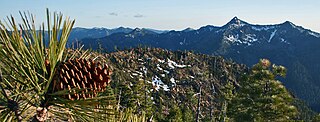
Serpentine soil is mostly derived from ultramafic rocks; In particular, serpentinite, a rock formed by the hydration and metamorphic transformation of peridotite. Peridotite is an ultramafic rock from the Earth's upper mantle. Serpentinite is composed of the mineral serpentine; the two terms are often used to mean the rock and soil.

Temperate coniferous forest is a terrestrial habitat type defined by the World Wide Fund for Nature. Temperate coniferous forests are found predominantly in areas with warm summers and cool winters, and vary in their kinds of plant life. In some, needleleaf trees dominate, while others are home primarily to broadleaf evergreen trees or a mix of both tree types. A separate habitat type, the tropical coniferous forests, occurs in more tropical climates.

Grasslands are areas where the vegetation is dominated by grasses (Poaceae); however, sedge (Cyperaceae) and rush (Juncaceae) families can also be found along with variable proportions of legumes, like clover, and other herbs. Grasslands occur naturally on all continents except Antarctica. Grasslands are found in most ecoregions of the Earth. For example, there are five terrestrial ecoregion classifications (subdivisions) of the temperate grasslands, savannas, and shrublands biome (ecosystem), which is one of eight terrestrial ecozones of the Earth's surface.
Though rare in general, the plant can be locally abundant, with the population at Ace Williams Mountain containing 400,000 to 800,000 individuals. [1]
Threats to this species include nickel mining, introduced species of plants, and poaching. Logging and grazing of cattle are threats, but these have been mitigated recently on federal lands. [1]

An introduced species is a species living outside its native distributional range, but which has arrived there by human activity, either deliberate or accidental. Non-native species can have various effects on the local ecosystem. Introduced species that become established and spread beyond the place of introduction are called invasive species. The impact of introduced species is highly variable. Some have a negative effect on a local ecosystem, while other introduced species may have no negative effect or only minor impact. Some species have been introduced intentionally to combat pests. They are called biocontrols and may be regarded as beneficial as an alternative to pesticides in agriculture for example. In some instances the potential for being beneficial or detrimental in the long run remains unknown.

Poaching has been defined as the illegal hunting or capturing of wild animals, usually associated with land use rights.

Logging is the cutting, skidding, on-site processing, and loading of trees or logs onto trucks or skeleton cars.



